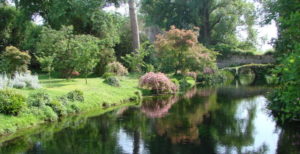
Among the remains of a medieval city in the ‘Lepini Mountains’ lies one of the ten most beautiful gardens in the world, the Garden of Ninfa![]() .
.
Already in Roman times a small temple was built next to the waters gushing from the mountains, dedicated to the Nymph goddesses of the woods and waters.
The town during its period of prosperity saw the construction of a double defensive wall, seven churches, some 180 houses, 14 towers, a castle, a town hall, and mills. Over the years, however, the fortification was attacked and destroyed several times, and the town that was destroyed was never rebuilt, also because of the malaria that infested the Pontine plain, the surviving citizens left, leaving behind the remains of a ghost town.
 With the passage of time and after a long period of neglect, around the beginning of the 20th century, the successors of the Caetani family returned to their estates, creating a marvellous, romantic-looking nymphaeum garden. After restoring some ruins including the bronze palace, cypresses, holm oaks, beeches and numerous rose plants were planted.
With the passage of time and after a long period of neglect, around the beginning of the 20th century, the successors of the Caetani family returned to their estates, creating a marvellous, romantic-looking nymphaeum garden. After restoring some ruins including the bronze palace, cypresses, holm oaks, beeches and numerous rose plants were planted.
Over the years, other types of shrubs and roses were planted on the eight hectares of land, including various types of old and modern roses, and later other varieties of plants were added, including deciduous magnolias, birches, marsh irises and a sensational variety of Japanese maples, as well as spectacular blossoming of cherry trees and ornamental apple trees in spring.
Among the more than 1,300 different plants introduced are viburnums, honeysuckles, ceanothus, hollyhocks, clematis, dogwoods and camellias.
 Ninfa’s particularly mild climate, favoured by the constant water temperatures of the river, also allows the cultivation of tropical plants such as avocados, South American gunnera manicata and banana trees.
Ninfa’s particularly mild climate, favoured by the constant water temperatures of the river, also allows the cultivation of tropical plants such as avocados, South American gunnera manicata and banana trees.
There are also many shrubs that are planted not only for their beauty but also because they offer hospitality to the many forms of animals present, among which the large group of avifauna, represented by more than 100 species surveyed, stands out.
Describing the natural environment of the Nymph Garden is not easy; here one can admire the progressive reappropriation of the territory by nature over the creations of man.
The natural monument includes two areas, that of the ruins of the medieval city and the English garden planted around the beginning of the 20th century and covering an area of about eight hectares, and the Pantanello area, renaturalised on a project started around 1990 and covering an area of about 100 hectares.
info: www.fondazionecaetani.org
